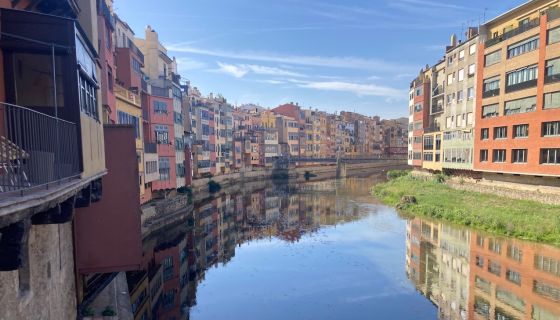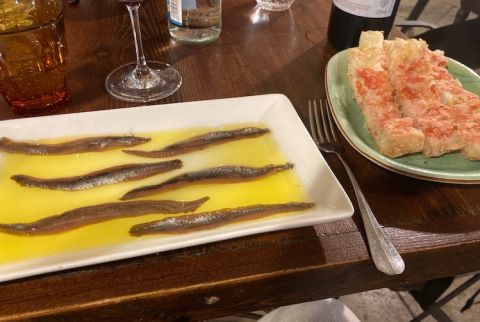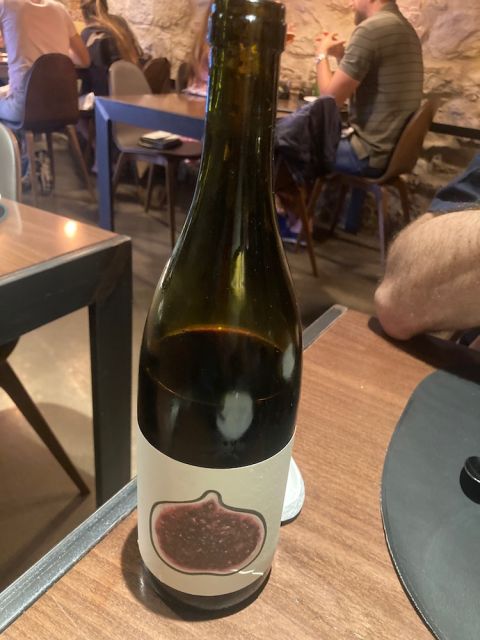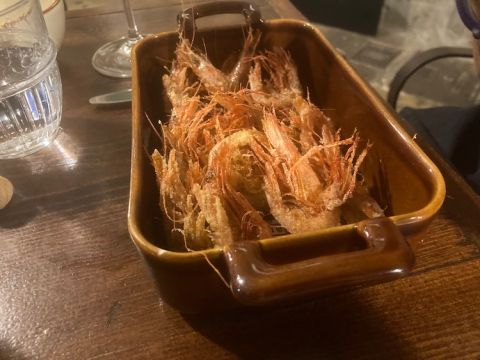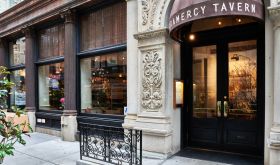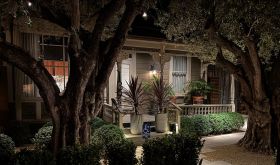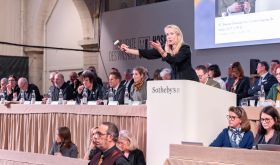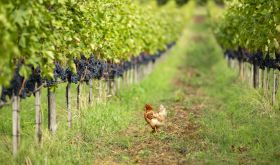The River Onyar naturally divides the city of Girona into two. There is the cathedral at one end, the Plaza Catalunya in the middle and numerous bridges across including the Palanques Vermelles built by the Eiffel company in 1827. On the left bank there is the city’s ‘ramblas’, a pedestrianised shopping street (beware cyclists), smaller and far more tranquil than Barcelona’s.
While most of this city at ground-floor level has been brought into the 21st century with glass frontages and all too familiar retail signs, very little has changed above this level. I spent a fascinating morning walking the streets of Girona looking up at the unusual array of architectural styles set against the blue of the sky. (That’s enough Pevsner, Ed).
From our base at the Roca brothers’ (of Can Roca) Casa Cacao, with its chocolate production on the ground floor, a cafe and shop for chocoholics across a narrow passageway and its extremely comfortable bedrooms above, I was able to explore this lovely city. The city has changed so much for the better in the 20 years since my last visit thanks apparently to the work of Joaquim Nadal, once the city’s mayor (local mayors can be extremely powerful in Spain apparently). I also found a good, wine-focused restaurant on each side of the river.
The first, SiNoFos (Catalan for ‘if it was not’), is only a few metres from our hotel but felt as though it were in a very different city. The door is black and firmly closed and only opens once you have rung an entry button, and then only somewhat reluctantly. We waited until the waiter answered and then several minutes of confusion followed. Examining the evening’s reservations on his iPad (of course), he could not see my name. I pulled out my iPhone to show him my confirmation email and eventually my Catalan friend, looking over his shoulder, spotted my name on his list. Apparently, I had already checked in! He apologised and showed us to our table.
The dining room is narrow and narrows towards the far end where there is an open kitchen. In front of the kitchen is a long, high table which can seat 16. In front of this is a series of tables for two, four and one of seven squeezed in next to our table of two. This restaurant is part of Gastronomicgrup who for 25 years have been in the meat-distribution business and own Porcus next door, a shop that seems to stock enough Iberico ham to satisfy any carnivore. They are to be congratulated on seeing the potential of the SiNoFos site.
Having said that, I have to add that this restaurant could have been anywhere: in New York with its dark-haired, bearded waiters in faux army combat jackets; in London with its layout, the exposed brickwork down one wall and the chef with his plugged earlobes; or in Paris with its emphasis on natural wines. We ate Catalan food and drank a bottle of Catalan wine, but both my guest and myself came away with the impression that we were not necessarily eating or drinking in Catalonia.
We enjoyed some Cantabrian anchovies; an aubergine dish with peanuts devised by the chef Rafael Peña, I was told; and a brioche filled with fried hake. All this was before the three highlights: some clams grilled with garlic; a delicious bowl of slightly smoked mussels; and some veal sweetbreads with mustard and mashed potatoes. We drank a bottle of La Figa (it bears a fig on the label) 2019, a carbonic maceration of Grenache and Cinsault that was highly enjoyable and managed to go with all the flavours of the food. My bill, with one dessert and no coffee, came to €136.50.
My Catalan friend then suggested a little walk and we crossed the Onyar to the ramblas side. ‘Twenty five years ago it wasn’t safe to walk here’, he observed,’but it is now so much safer.’ The streets were busy, even at 11 pm, and the cafe tables were all full. We walked into the Plaça del Vi and he pointed out the busy restaurant Plaça del Vi 7, with its tables under the atmospheric colonnades, before we carried on. Assured by my friend, who is steeped in the hospitality business, that they have a very good wine list, I decided to return.
I did so, the following day, at lunch and dinner, the former to do a recce to decide whether it was of a sufficiently high standard for my discerning wife. Anywhere whose wine list opens with three different sherries by the glass has to be good enough!
Their lunch menu, €23.50 for three courses including a glass of wine and water, is not only very good value but also shows the intelligent use of inexpensive ingredients in the kitchen. I began with scrambled eggs and Iberico ham before moving on to a very Catalan rice dish with squid and wild mushrooms. Both were well cooked and generous in their serving, and both suited my glass of Hidalgo Oloroso Gobernador, which was excellent. Only the dessert – the base of a crema catalana without the crisp topping – was disappointing, and showed yet again that there should be no mucking about with classic desserts.
Although on our return we were sitting at a table close to where I had been at lunch, the restaurant felt very different. There was an almost medieval feeling as we sat under the colonnade and this was an excellent place to watch the citizens of Girona as they came home from work to take their dogs out for a walk. I was able to take all this in while Jancis perused their wine list, on an iPad, and the menu, on a blackboard (with the heading ‘from the market to your plate’) and in English, which was brought in front of us. The range of wines on offer here is very broad, with wines from all over the world, and there was considerable discussion before we settled, with Walter’s recent warning in mind, on an excellent bottle of Dolcetto 2018 from Burlotto.
My enthusiasm for anchovies did not really test the kitchen but the other three dishes we ordered certainly did and the food proved as good as at lunchtime. We chose a stylish bowl of refreshing gazpacho, retaining its temperature thanks to some tomato-juice ice cubes; a large dish of tiny, crisp, fried prawns from nearby Pálamos, above, with a bowl of lime mayonnaise; and, best of all, a dish of four scallops with a Béarnaise sauce and the addition of cubes of candied watermelon, which added an extra dimension of freshness and just a touch of sweetness. A lesson to be learnt and applied at home. My bill came to €103 not including the people-watching. There was no dessert as we had already spotted the top-quality chocolate left in our bedroom!
Casa Cacao Plaça Catalunya 23, 17002 Girona, Spain; tel: +34 972 905 905
SiNoFos Plaça Catalunya 25, 17002 Girona, Spain; tel: +34 972 009 333
Plaça del Vi 7 Plaça del Vi 7, 17004 Girona, Spain
The case of the disappearing café con leche
This cup of very particular coffee has been a favourite of mine since my first visit to Bilbao in 1977. Hot, slightly sweet, a shot of espresso cut with a small quantity of hot, very Spanish milk, café con leche was a drink that would signify my arrival in Spain. Today, very sadly, it does not seem to exist.
I ordered it every morning I was in Mallorca recently and for each breakfast in Girona. The waiter on each occasion accepted my order but served me a cappuccino with steamed frothy milk. This is not café con leche, where the hot milk, not frothy, is mixed in with the shot of espresso to generate a slightly sweet coffee that is unique to this country.
When I asked Jordi Subirós, the hotelier behind the Hotel Empordà in Figueres, about this his response was immediate, ‘Blame Starbucks’, he responded. ‘They have made such stars out of our baristas that they want to put frothy milk on the top of every cup of coffee.’
This is a great shame.

